Walking among the modern high-rises and Soviet apartment blocks in Yerevan’s orderly street grid, I detect hints of charred fat and wood smoke. It’s an aroma I first encountered just after I crossed the border into Armenia. It saturated the minibus as we swerved through the rugged Caucasus Mountains toward the nation’s capital. And it has dogged me since.
It is khorovats, the local barbecue, as heavy with tradition and culture as its counterpart in the American South. In Armenia, it’s the taste of every family event—the grill, called a mangal, an expected guest itself. The ability to afford khorovats a few times a month is considered a mark of comfort. There’s even a song played when the meat platter is brought into a party.
Though the word means anything grilled, khorovats implies pork—chops and ribs—roasted over a fire using flat skewers called shampurs. The meat is simply seasoned: salt, pepper, chopped onions, maybe paprika and a dried local herb such as tsitron, similar to oregano. Liquid marinades are less traditional, but these days young people get more creative.
“I’m thinking about doing pomegranate and basil, but my dad says that will ruin it,” says Arpine Yesayan, my guide from the Envoy Hostel in Yerevan.
As I walk the city, the aroma of grilling meat reaches out, but I save my appetite. Arpine tells me the pork is juicier in the countryside, and she invites me to her parents’ house in Chinchin, a village of 400 people.
The town is only 100 miles away, but the journey takes four hours of bumping along pot-holed roads, our ears popping as we wind through mountainous scrubland and cleared landslides. Along the way, we stop at a bakery on the shore of Lake Sevan to pick up several pounds of lavash—an ancient, ubiquitous flatbread—and a selection of layer cakes and gooey baklava.
We arrive at the house after dark. Arpine’s father, Andranik, one arm in a sling after a recent fall, has already built a fire in the grill to make dinner. Working under a floodlight, he uses his good hand to form a mixture of ground beef, pork belly and onion around the shampurs; the skewers’ flat shape conducts more heat.
Inside the house, the table is set with over a dozen plates: sautéed mushrooms covered in garlic yogurt, tomato-cucumber salad, spicy stewed peppers, soft cheese, cured beef, pork sausage, lavash and a pile of fresh dill, cilantro and basil. The kebabs are stacked on top of pickled cucumbers and banana peppers. “That’s the never-ending problem of Armenian tables,” Arpine says. “There’s never enough space.”
A series of toasts begins, each paired with vodka that Andranik distilled from apples. The first gives thanks for the meeting itself. Then come blessings for the parents, the grandparents, the recent wedding of Arpine’s friends. The kebabs drip with savory pork fat, and vodka flows freely during the three-hour dinner.
I wake the next morning, still full from the night before, to the sound of crowing roosters and chopping wood. Andranik is already preparing the next fire; he seasoned the meat not long after dawn. Breakfast is a spread of lavash, sliced sausages, cheese, hard-cooked eggs, apple wedges, blackberry jam and strong Turkish-style coffee. A pot of chunky honey, kept in the freezer to give it a thicker consistency, came from an aunt’s beehives down the road.
There’s hardly a moment to digest before the khorovats begins in earnest. Andranik stacks the wood on the mangal at right angles, log-cabin style, to promote airflow so the fire reaches the highest temperature possible. A light drizzle forces us to bring the grill into the garage, and a centuries-old progression plays out in precise order.
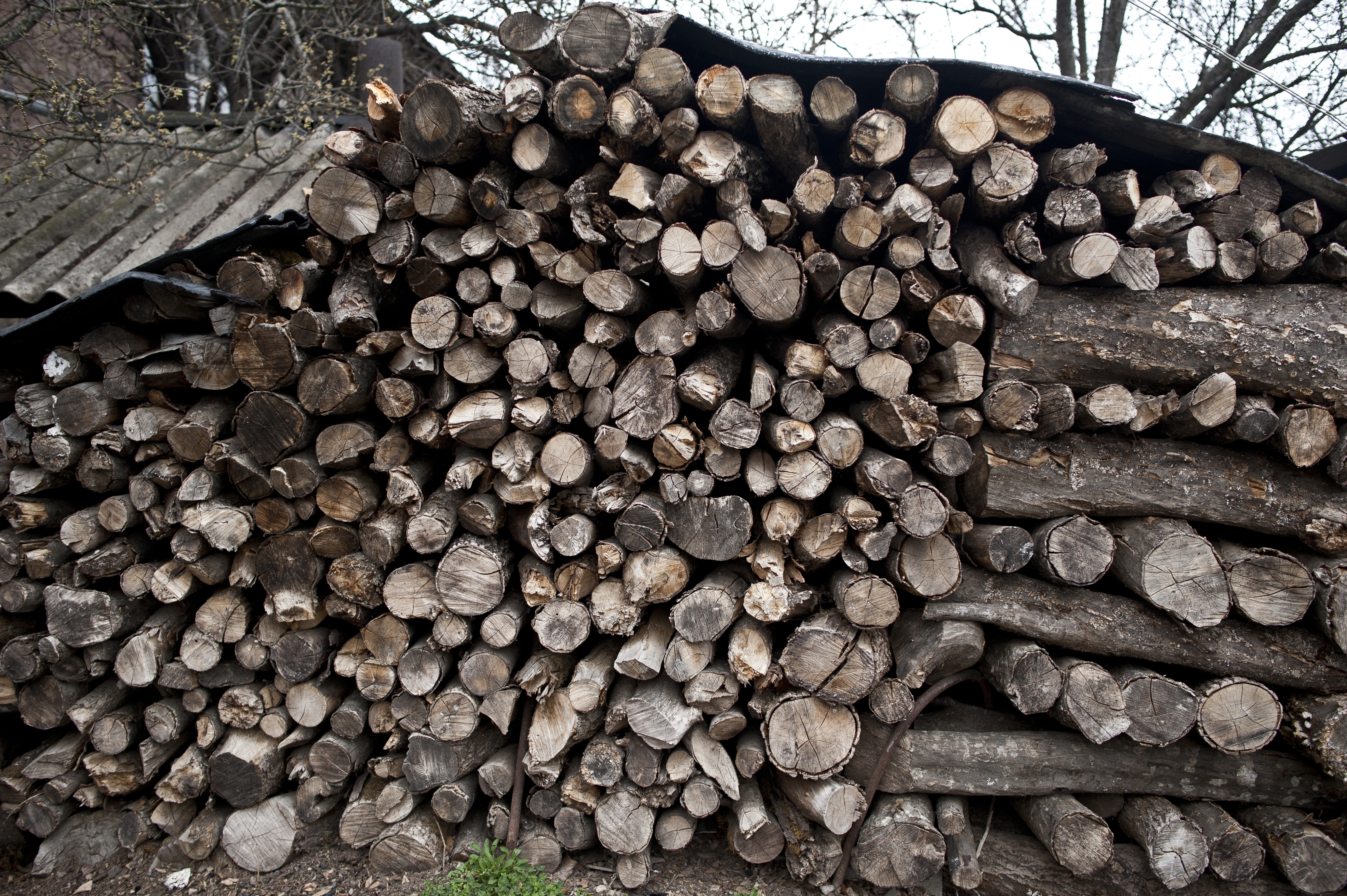
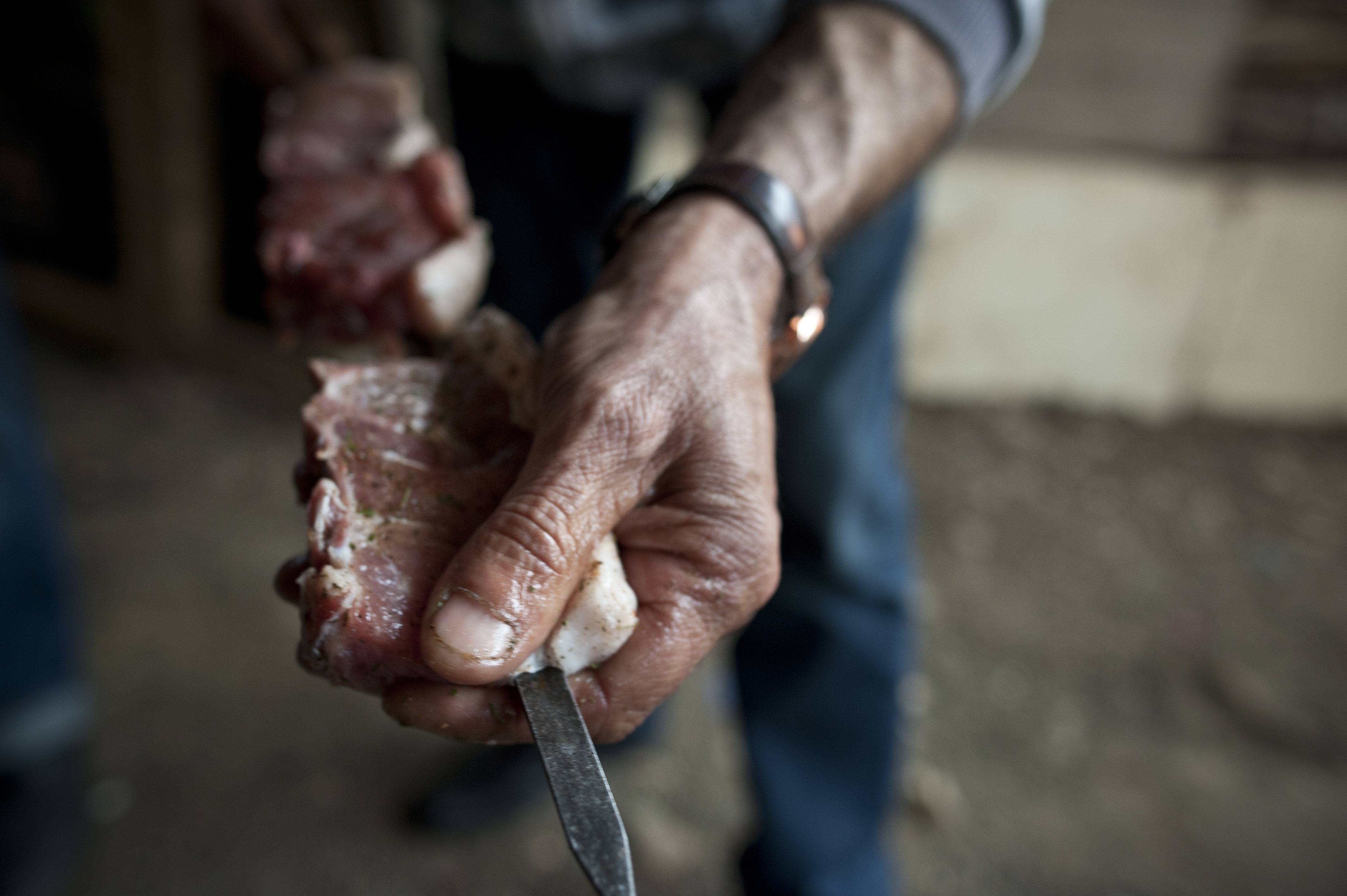
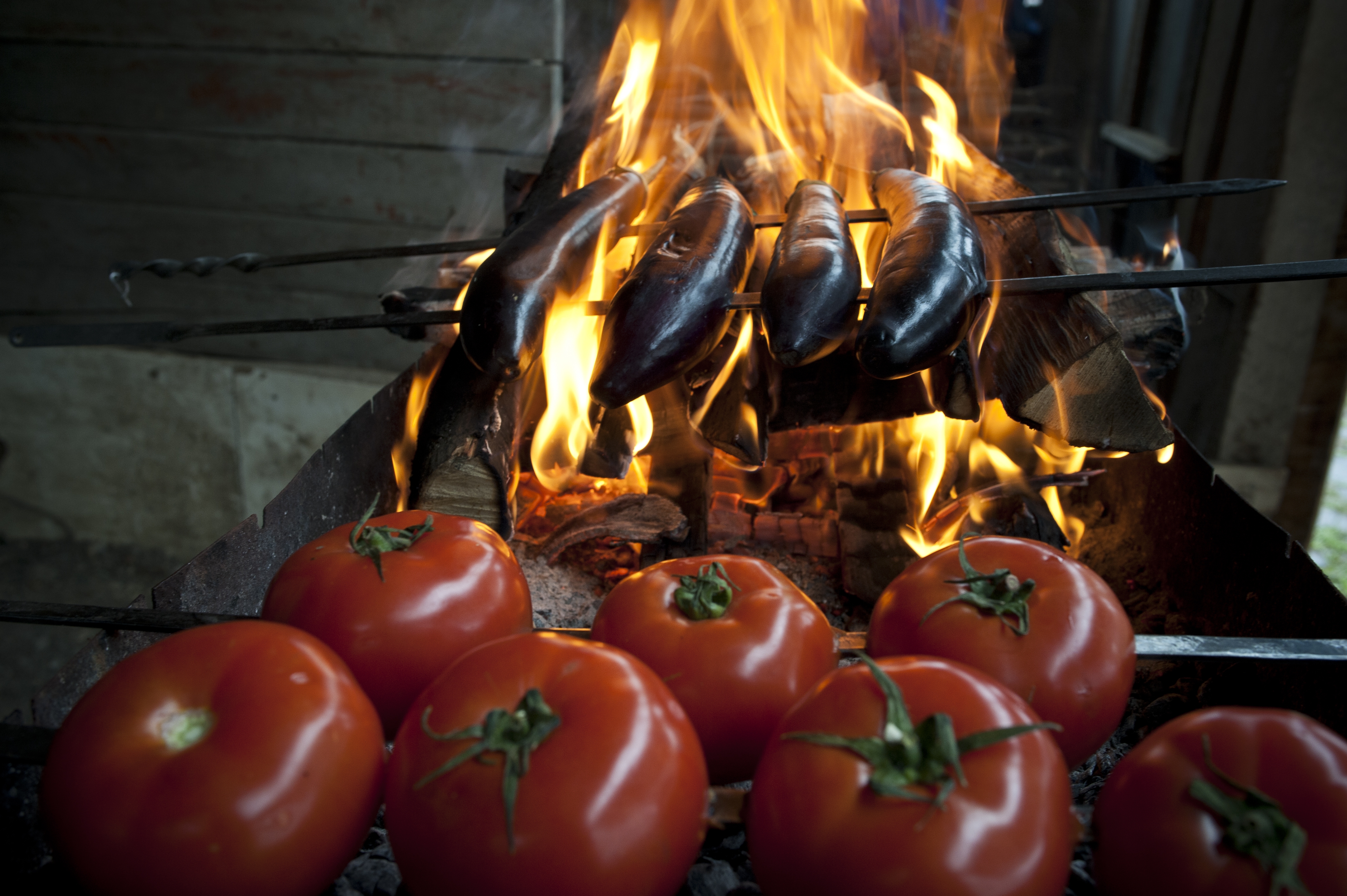
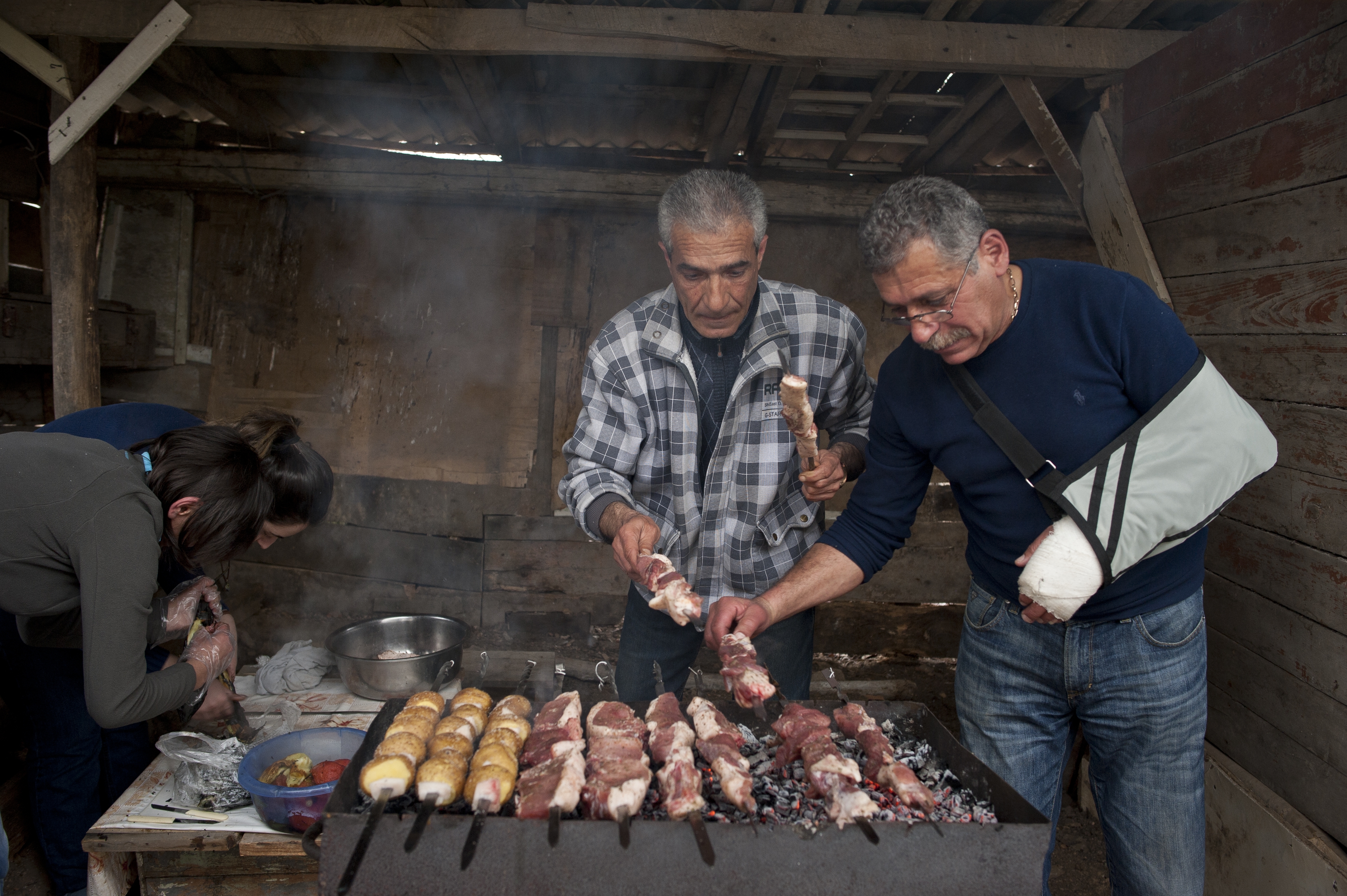
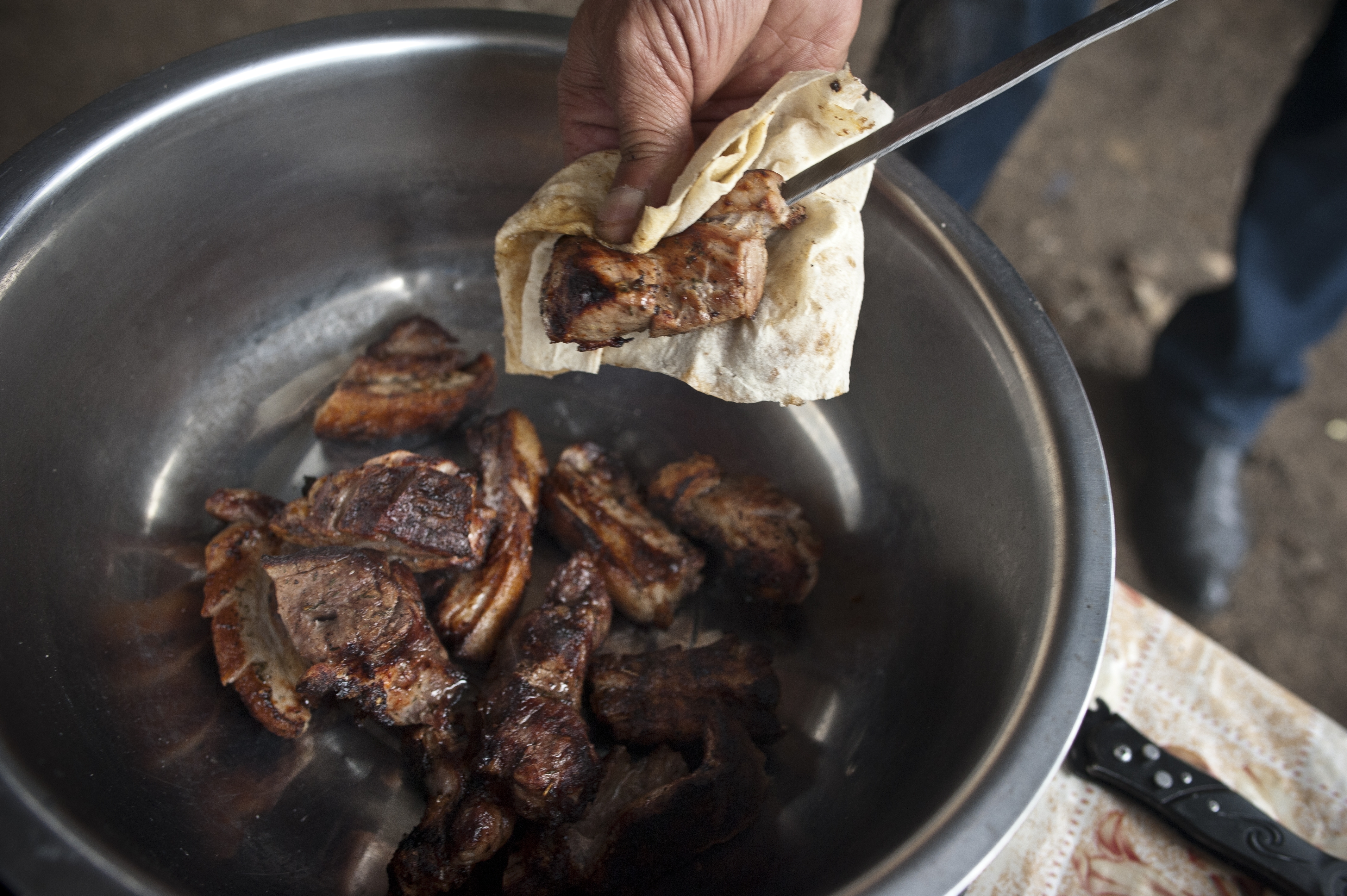
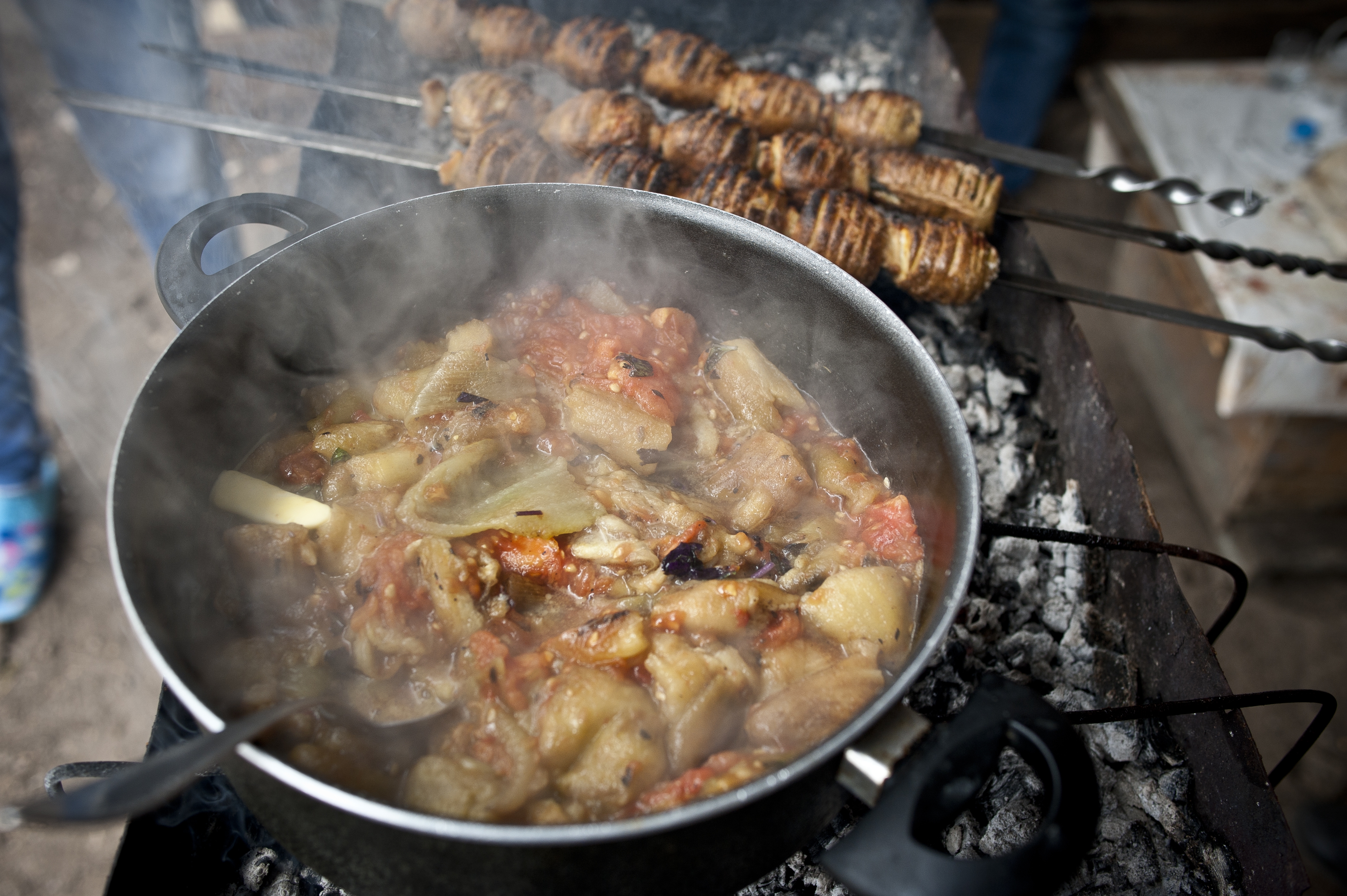
The chops and ribs are skewered with the small pieces at either end, sandwiching thicker ones in the middle so they cook over the hottest coals. Vegetables will be cooked separately.
At the peak of the fire, skinny black eggplants are thrust into 2-foot flames. As the flames die down, green and yellow peppers are laid directly on the burning logs. Tomatoes go on last, their skin bubbling as the juices seep out, sizzling onto the coals. The vegetables are completely charred, then sealed in a plastic bag to steam, so the skins separate from the flesh. Once cool enough to handle, the women peel them.
The men turn their attention to the meat, rearranging the coals and placing the skewers above the heat. “We have a saying that only Armenian men do khorovats,” one man says with a smile. “But it’s the only thing they can do.”
Skewered potatoes—scored several times, rubbed with coarse salt and interspersed with chunks of pork fat—go onto half of the grill at the same time as the meat.
The garage fills with smoke as the fat begins to drip and hiss. Charred pieces of pork are cut off with a switchblade to check for doneness, the first step of a constant dance of slicing, tasting and shuffling coals and meat to find the right heat. They’re finally pulled off the skewers using a piece of lavash like an oven mitt, and I’m invited to take the sacred first bite from a rib.
The fat is charred and crunchy, the meat supremely tender, redolent of smoke. The juices drip down my fingers, covering my hand.
Inside, many of the same adornments from the night before are laid out—this spread appears at nearly every big meal—only this time more people crowd the table. The same progression of toasts begins: to the meeting, the parents, the grandparents and more, and by the time we start eating, the meat is completely cool. Even so, it’s some of the juiciest pork I’ve ever had.
The charred, peeled vegetables have been chopped and stewed with butter and fresh basil; they taste smoky and rich. The potatoes absorbed the pork fat and salt, their skin crisp and interior creamy. I start making wraps with the lavash, vegetables and herbs, but I stop when I notice everyone else eating each bit individually, appreciating the simplicity of the pork. We use our hands, nibbling herbs between bites of meat.
As we finish, we realize we forgot to play the khorovats song. Arpine tries pulling it up, but the Wi-Fi is on the fritz. “Well,” she tells me, “that means you’ll have to come back.”
Back at Milk Street, we knew it would be difficult to improve upon the ancient combination of pork, fire and salt, so it was a matter of adapting what we learned to standard charcoal and gas grills. We also decided to simplify the charred vegetables by omitting the eggplant, upping the peppers and tomatoes and making a chunky sauce.
Pork is butchered differently in Armenia, so we chose to replicate the traditional marbled cuts with pork chops. Meaty, blade-end rib chops worked best, though any chop style worked as long as they were at least an inch thick. Skewering was unnecessary.
Though wet seasonings are uncommon in Armenia, we found a marinade a more efficient way to boost flavor. Instead of onion slices and flavorings, we blended the onions, olive oil, oregano, salt and pepper in a food processor to create a pungent paste, then coated the pork in a thick layer. Letting it sit for at least two hours—and up to overnight—ensured even flavor.
After heating the grill, we started the sauce first, coating plump, ripe plum tomatoes and cubanelle peppers with olive oil and lightly charring them. We transferred the vegetables to a disposable foil pan with garlic, butter and oregano to slowly finish cooking. While the vegetables broke down into a chunky sauce, we started the pork chops on the cool side of the grill, set above a foil packet of fruitwood chips, to replicate the thick, flavor-enhancing smoke native to Armenian grilling. After 10 minutes, we moved the pork to the hot side of the grill.
A splash of tangy red wine vinegar balanced the buttery sauce, which paired perfectly with the juicy pork. The chops’ smoky, herbal aromas evoked the best of Armenian barbecue, without the need for a special grill.





